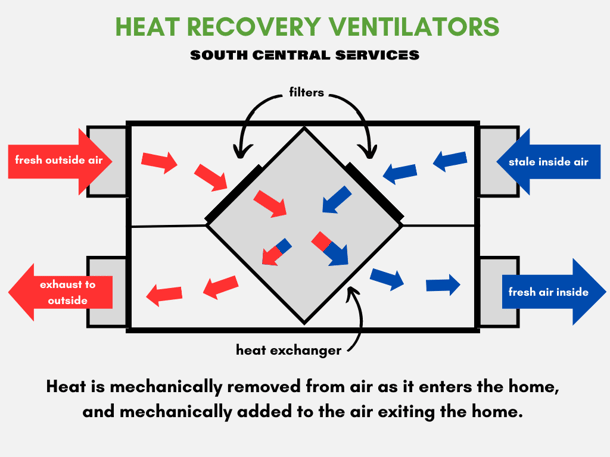How Does HRV and How It Works
Wiki Article
The All-Inclusive Guide to the Uses of Heat Recovery Ventilation in Modern Buildings
Heat Recovery Ventilation (HRV) systems stand for a significant innovation in developing modern technology (HRV Heat Recovery Ventilation). They supply a method for exchanging stagnant interior air with fresh outside air while minimizing energy loss. This strategy not only boosts indoor air top quality but also adds to energy effectiveness in both property and business buildings. Recognizing the various applications and advantages of HRV can reveal its critical role in contemporary design and sustainability efforts. The effects of this technology deserve discovering furtherComprehending Heat Recovery Ventilation Equipments

Lots of contemporary structures focus on power effectiveness, understanding warm healing air flow (HRV) systems is essential for maximizing interior air quality and reducing energy consumption. HRV systems work by transferring heat from stale indoor air to incoming fresh air, efficiently preserving comfortable interior temperature levels while minimizing energy loss. These systems include a warmth exchanger, fans, and ductwork that promote the blood circulation of air. During winter, HRV units catch and recycle warm from the outbound air, while in summer, they can aid cool down incoming air. By continually trading air, HRV systems likewise minimize humidity and the concentration of interior toxins. Appropriate setup and maintenance of HRV systems are vital for their effectiveness and effectiveness in boosting total building efficiency and convenience.
Advantages of Heat Recovery Ventilation
Heat recovery ventilation systems provide numerous advantages that improve both power effectiveness and indoor air quality in modern structures. By recording and reusing energy from exhaust air, these systems greatly lower cooling and heating prices, causing lower power intake. They maintain a stable circulation of fresh outside air, minimizing the threat of interior air contaminants and allergens. This continuous exchange aids regulate moisture degrees, preventing mold growth and making certain a much healthier living setting. Furthermore, HRV systems contribute to sustainability goals by lowering total carbon impacts. Their capability to optimize ventilation without sacrificing thermal comfort makes them a valuable enhancement to modern building layout, advertising both economic and environmental advantages.Applications of HRV in Residential Buildings
As house owners increasingly prioritize energy performance and indoor air high quality, the applications of heat recuperation ventilation (HRV) systems in property buildings have actually ended up being much more common. HRV systems are specifically useful in tightly sealed homes, where preserving fresh air circulation is important for preventing moisture accumulation and indoor toxins. They successfully transfer warm from outward bound stale air to inbound fresh air, decreasing energy expenses related to heating & cooling. In addition, HRVs can enhance comfort levels by managing moisture you can look here and temperature. They are likewise adaptable for different household layouts, consisting of single-family homes and find here multi-unit structures. Generally, incorporating HRV systems sustains sustainable living methods while guaranteeing a healthier indoor environment for occupants.HRV in Commercial and Industrial Settings
In commercial and commercial setups, the application of warm healing ventilation (HRV) systems has actually come to be significantly crucial for maximizing power effectiveness and preserving air quality. These systems effectively move warm from exhaust air to incoming fresh air, lowering the demand for additional heating or cooling. This not only decreases power costs yet likewise contributes to sustainability campaigns. Industries such as production, warehousing, and office complex benefit significantly from HRV systems, as they help manage temperature and moisture degrees, ensuring a comfy and efficient atmosphere. Moreover, HRV systems help in removing impurities and excess wetness, enhancing interior air top quality. As guidelines around air high quality come to be more stringent, the fostering of HRV technology is most likely to grow, making it an essential component of contemporary commercial and commercial infrastructure.Future Fads in Heat Recovery Ventilation Technology

Regularly Asked Questions
How Does Heat Recovery Ventilation Influence Indoor Air High Quality?
Heat recovery ventilation greatly boosts indoor air top quality by constantly exchanging stale interior air with fresh outdoor air while recuperating power. This process minimizes toxins, preserves optimal humidity levels, and assures a much healthier atmosphere for residents.Can HRV Systems Be Mounted in Existing Structures?
HRV systems can indeed be mounted in existing buildings. Retrofitting may call for adjustments to ductwork and ventilation formats, however it considerably boosts energy efficiency and indoor air quality, making it a sensible choice for older structures.What Upkeep Is Required for HRV Equipments?

Exist Certain Climates Where HRV Is Much More Efficient?
Heat recovery ventilation systems are particularly efficient in environments with considerable temperature distinctions in between periods. These systems maximize power efficiency by recuperating warm from exhaust air, making them optimal for both cold and moderately cozy settings.How Do HRV Equipments Affect Energy Bills?

Report this wiki page